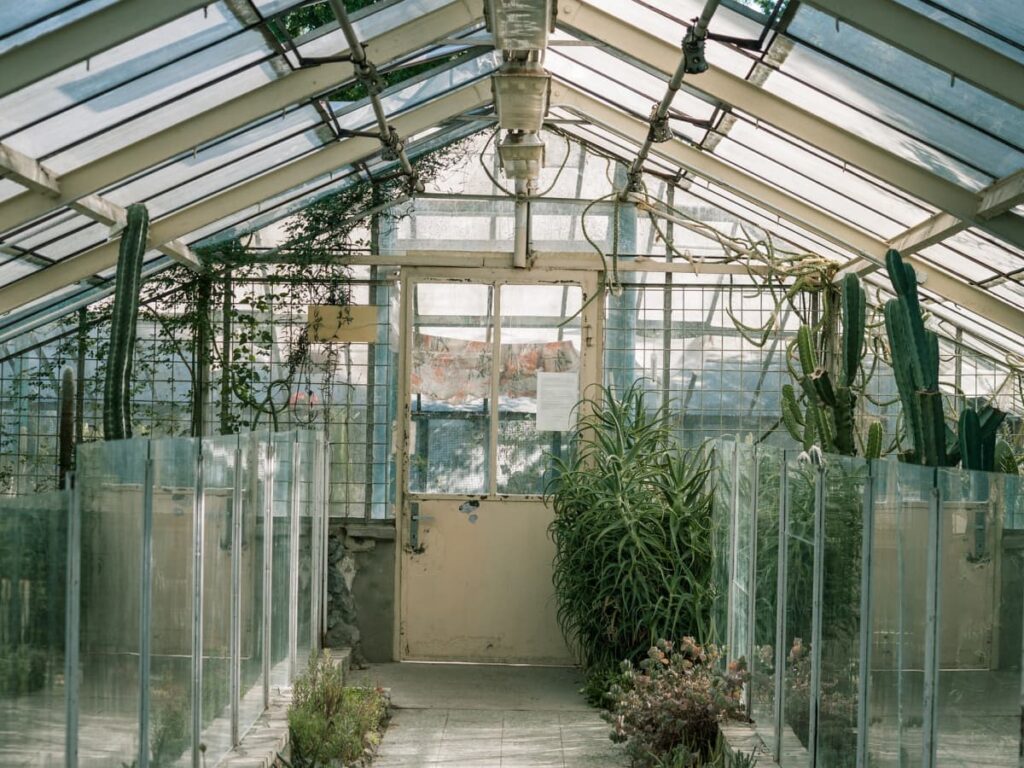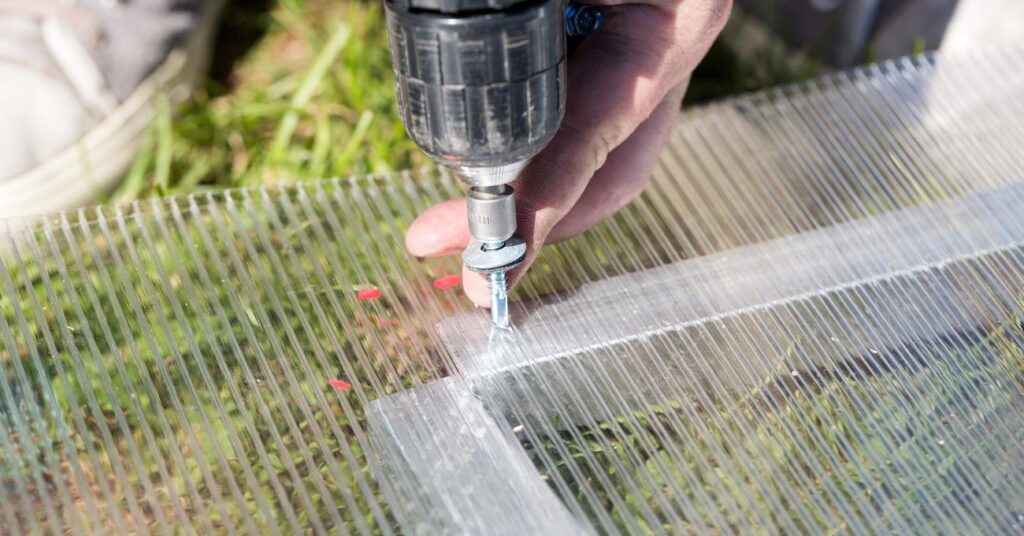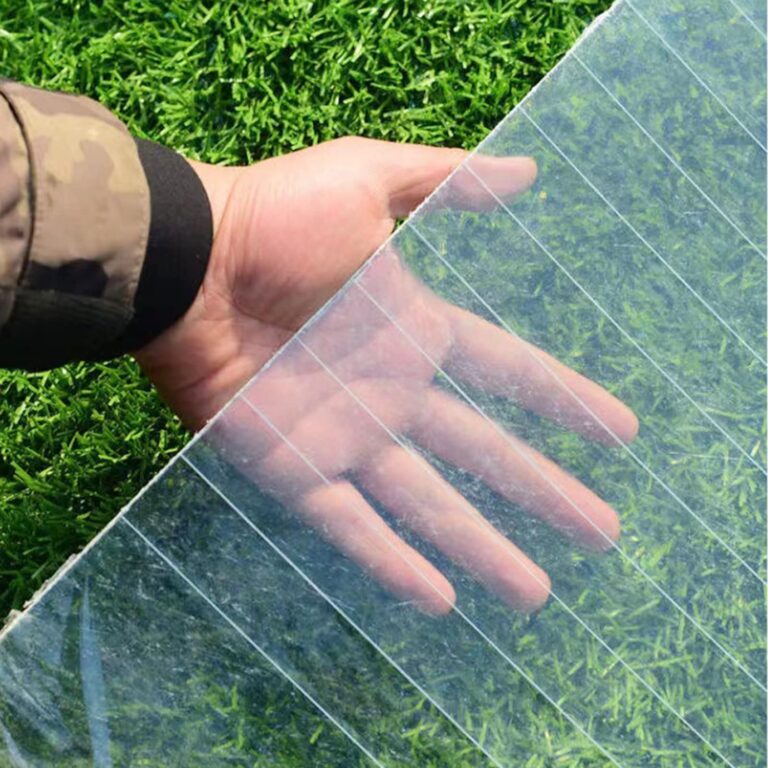During the early stages of my greenhouse gardening adventure, I was entranced by the notion of creating a mini-paradise within my backyard. The dream was vivid: an abundant oasis where fragile orchids, lush vegetables, and exotic blossoms could thrive throughout the year, shielded from the unpredictability of weather and temperature. But there was one thing bugging me: the thickness of the greenhouse’s polycarbonate sheets.
You might be wondering, “Why does the thickness matter?” Well, it turns out it’s a big deal. The thickness of those sheets can make or break your greenhouse experience. As I jumped into the world of polycarbonate and greenhouses, I learned some valuable secrets. And now, I want to share them with you.
For mild to moderate climates, 4mm to 6mm polycarbonate sheets are the go-to choice. But if you’re in a scorching hot place, like a tropical paradise or a desert, thicker sheets, around 8mm to 10mm, are your best friends. They keep things cool and protect your plants from too much sunlight.
Now, if you’re facing heavy snowfall, like I do in the winter, you’ll want to beef up your greenhouse with 10mm to 16mm sheets. These thick sheets ensure your greenhouse stands strong against the snow and keep your plants cozy inside
Why Polycarbonate is Ideal for Greenhouses

Polycarbonate sheets have earned their reputation as the go-to material for greenhouse construction for a multitude of compelling reasons. These transparent panels, composed of high-quality thermoplastic polymer, offer a winning combination of properties that cater to the unique needs of greenhouse gardening.
Optimal Light Transmission:
Polycarbonate sheets possess a unique ability to allow sunlight to flood your greenhouse. But it’s not just about quantity; it’s about quality. These sheets diffuse light evenly, ensuring that every plant, from the tallest tomato vines to the smallest delicate blooms, receives its fair share of sunshine. No more worries about shaded corners or sunburned leaves—your plants will thrive in a perfectly lit environment.
Besides, It is an excellent choice for greenhouse construction due to its ability to block UV rays while allowing sunlight and heat to enter. This plastic boasts an impressive light transmittance rate of 88%. Furthermore, it’s available in both clear and opaque variations, offering versatility for greenhouse design.
Unmatched Durability:
Greenhouses face a barrage of challenges, from pounding rain to heavy snow and hail. Polycarbonate stands strong against these elements. Its high-impact resistance means you won’t have to fret about cracks or shattering like you would with traditional glass. Your greenhouse will weather storms and seasons, staying in tip-top shape for years to come.
Exceptional Insulation:
Greenhouse gardening is all about creating a cozy, climate-controlled haven for your plants. Polycarbonate helps you achieve this with its remarkable insulation properties. It traps heat during chilly nights, ensuring your plants stay warm and snug. On hot summer days, it prevents overheating, creating an environment where your flora can flourish without the stress of extreme temperature fluctuations.
Easy to Work With:
Polycarbonate is a dream to work with, especially when compared to heavy, breakable glass. Its lightweight nature makes installation a breeze, reducing the risk of accidents and simplifying the construction process. Whether you’re a seasoned greenhouse enthusiast or a first-time gardener, you’ll appreciate the user-friendly qualities of polycarbonate.
UV Protection:
While your plants crave sunlight, too much of a good thing can lead to problems. Polycarbonate sheets often come with built-in UV protection. This shields your plants from harmful UV rays, preventing sunburn and damage. It’s like giving your plants sunscreen, ensuring they bask in the sun’s glory without the risk of harm.
In summary, the choice of polycarbonate for your greenhouse is a decision grounded in practicality and a deep understanding of the unique needs of your plants. Its ability to enhance light quality, withstand the harshest elements, provide superior insulation, and offer ease of use makes it the ideal companion for your greenhouse gardening journey.
Finding the Right Thickness for Your Greenhouse
Choosing the right thickness for your greenhouse’s polycarbonate sheets is a pivotal decision that can make or break your gardening experience. It’s like tailoring a suit to fit you perfectly; the right fit ensures comfort and style, while the wrong fit can be uncomfortable and disappointing.
Your location on the map and the local climate paint the first strokes of this thickness masterpiece. Is your area known for temperate, mild weather, or does it experience extremes? For regions where harsh weather is a rarity, opting for thinner polycarbonate sheets, usually in the 4mm to 6mm range, is often the sweet spot. These provide decent insulation without stretching your budget.
Every greenhouse has a unique mission. Is yours a sanctuary for delicate blossoms, a bustling vegetable haven, or a serious commercial growing operation? The intended use of your greenhouse significantly influences your thickness choice. In regions where sunlight and heat are intense, such as tropical or desert environments, thicker sheets, approximately 8mm to 10mm, are the prudent choice. They offer enhanced thermal insulation and vital UV protection, ensuring your plants thrive under the blazing sun.
4mm Polycarbonate: A Versatile Greenhouse Solution
When it comes to selecting the right polycarbonate thickness for your greenhouse, 4mm is a versatile and popular choice. Here’s why:
- Adequate Insulation: While 4mm polycarbonate isn’t the thickest option available, it provides reasonable insulation. It can help moderate temperature fluctuations inside the greenhouse, protecting your plants from extreme cold or heat.
- Durability: Polycarbonate, in general, is known for its durability. Even at 4mm thickness, it can withstand impacts and harsh weather conditions, ensuring your greenhouse remains structurally sound.
- Light Transmission: 4mm polycarbonate still allows a good amount of natural sunlight to pass through. This is crucial for your plants’ photosynthesis and overall health.
- Cost-Effective: Compared to thicker polycarbonate sheets, 4mm sheets are often more budget-friendly. This makes them an attractive option for greenhouse owners looking for a balance between performance and cost.
- Versatility: 4mm polycarbonate is suitable for a wide range of climates. While it may not be ideal for extreme conditions, it works well in regions with relatively mild weather.
- DIY-Friendly: If you’re a DIY enthusiast, working with 4mm polycarbonate is manageable. It’s not too heavy or difficult to handle, making it a good choice for greenhouse projects where you plan to do the installation yourself.
- Additional Insulation Options: If you find that 4mm polycarbonate doesn’t provide enough insulation for your specific needs, you can always supplement it with insulation films, thermal curtains, or additional heating solutions.
6mm Polycarbonate: Enhanced Insulation for Your Greenhouse
If you’re looking for improved insulation and protection for your greenhouse, 6mm polycarbonate might be just the right choice. Here’s why 6mm polycarbonate is a popular option for greenhouse owners:
Increased Thermal Insulation: One of the key advantages of using 6mm polycarbonate is its superior thermal insulation properties. Thicker sheets naturally provide better insulation, helping to maintain a more stable and comfortable environment for your plants. This is particularly valuable in regions with extreme temperature fluctuations.
Enhanced Durability: Polycarbonate, known for its durability, becomes even more robust at 6mm thickness. It can withstand impacts, hail, and heavy snow loads, ensuring the structural integrity of your greenhouse.
Improved UV Protection: Thicker polycarbonate sheets like the 6mm option often come with enhanced UV protection. This shields your plants from excessive sunlight exposure and helps prevent damage caused by UV radiation.
Greater Light Diffusion: Despite being thicker, 6mm polycarbonate still allows ample natural light to enter the greenhouse. In fact, its light diffusion properties can benefit your plants by distributing sunlight more evenly, reducing the risk of sunburn or shading.
Extended Lifespan: Due to its durability and resistance to yellowing, 6mm polycarbonate can have a longer lifespan compared to thinner alternatives. This can be a wise investment in the long run.
Suitable for Year-Round Cultivation: With its superior insulation, 6mm polycarbonate is an excellent choice for year-round greenhouse gardening. It helps maintain consistent temperatures during both hot summers and chilly winters, accommodating a wider range of plants.
Reduced Energy Costs: While the initial cost of 6mm polycarbonate may be higher than thinner options, its superior insulation can lead to significant energy savings. You’ll spend less on heating and cooling, making it cost-effective over time.
Versatile for Various Climates: Whether you’re in a region with harsh winters or hot summers, 6mm polycarbonate can adapt to various climates, providing the insulation needed to create an optimal growing environment.
8mm and Beyond: Thicker Polycarbonate for Greenhouse Excellence
When it comes to creating the ideal greenhouse environment, thicker polycarbonate sheets, such as 8mm and beyond, offer a range of benefits that can help your plants thrive in various conditions. Let’s explore why you might consider these thicker options:
Exceptional Insulation: Thicker polycarbonate sheets, starting from 8mm and beyond, provide outstanding thermal insulation. This level of insulation is especially valuable in regions with harsh winters and hot summers. It helps maintain a stable and comfortable climate for your plants year-round.
Enhanced Durability: Polycarbonate is already known for its durability, but thicker sheets are even more robust. They can withstand heavy snow loads, hail, and strong winds, ensuring the long-term structural integrity of your greenhouse.
Superior UV Protection: Thicker polycarbonate often comes with advanced UV protection. This shields your plants from excessive sunlight exposure and prevents damage caused by harmful UV radiation. It’s especially beneficial for sensitive plants.
Excellent Light Diffusion: Despite their thickness, these sheets allow ample natural light to penetrate the greenhouse. They often have excellent light diffusion properties, distributing sunlight more evenly throughout the space. This reduces the risk of sunburn or shading on your plants.
Longer Lifespan: Thicker polycarbonate sheets are more resistant to yellowing over time. This means they can maintain their clarity and performance for an extended period, offering a better return on your investment.
Energy Efficiency: While thicker polycarbonate may have a higher initial cost, it can lead to significant energy savings. The enhanced insulation reduces the need for heating and cooling, making your greenhouse more energy-efficient in the long run.
Versatile for Challenging Climates: If you’re in a region with extreme weather conditions, such as heavy snowfall or scorching heat, thicker polycarbonate sheets can adapt and protect your plants effectively. They provide the insulation needed to create a controlled environment.
Ideal for Year-Round Gardening: Thicker polycarbonate is well-suited for year-round greenhouse gardening. It helps regulate temperatures during both frigid winters and sweltering summers, allowing you to grow a wide variety of plants.
4mm Vs 6mm Vs 8mm+
| Polycarbonate Thickness | Insulation Quality | Durability (Years) | UV Protection Quality | Light Diffusion Quality | Lifespan (Years) | Energy Efficiency | Versatility |
| 4mm | Adequate | 10-15 | Moderate | Good | 10-15 | Moderate | Versatile for mild climates |
| 6mm | Enhanced | 15-20 | Superior | Excellent | 15-20 | Cost-effective | Suitable for a wide range of climates |
| 8mm or Beyond | Exceptional | 20+ | Excellent | Excellent | 20+ | Energy-efficient | Ideal for extreme weather conditions |
How to calculate the ideal polycarbonate thickness for your greenhouse:

Determine Your Climate Zone:
Understanding your climate zone is the foundational step in selecting the right polycarbonate thickness. Climate zones are typically categorized as mild, moderate, or extreme. Consult climate data specific to your area, considering factors like temperature ranges, precipitation levels, and the frequency of extreme weather events. This information will help you gauge the level of insulation your greenhouse requires to maintain a suitable environment for your plants.
Define Your Greenhouse Goals:
Your greenhouse’s purpose plays a significant role in thickness calculations. Consider the types of plants you intend to grow and their specific temperature requirements. Are you cultivating heat-loving tropical plants, cold-sensitive orchids, or a combination of both? Knowing your greenhouse’s primary mission helps determine the level of insulation needed to meet your plants’ needs.
Consider Temperature Extremes:
Take into account the temperature extremes experienced in your region. If your area encounters sweltering summer heatwaves or freezing winter cold snaps, these extremes should be factored into your calculations. Extremes influence the required level of thermal insulation to keep your greenhouse comfortable for plants year-round.
Calculate U-Value:
The U-value (thermal transmittance) quantifies how efficiently a material conducts heat. It’s a critical metric for greenhouse insulation. Calculate the U-value based on your climate zone and temperature extremes. A lower U-value indicates better insulation. The formula for calculating the U-value considers the thermal conductivity of the material (polycarbonate), its thickness, and the temperature difference between the inside and outside of the greenhouse. You may need to consult professionals or use specialized software to perform these calculations accurately.
Factor in Additional Features:
If you plan to incorporate extra insulation features, such as thermal curtains, insulation films, or heating systems, consider their impact on overall insulation capacity. These additions can reduce the insulation requirements for your polycarbonate sheets, potentially allowing for thinner options.
Calculate Light Transmission:
It’s crucial to balance insulation needs with adequate light transmission for your plants. Thicker polycarbonate sheets can slightly reduce light transmission. Calculate the amount of natural sunlight required for your specific plant varieties. Consider factors like the positioning of your greenhouse, the orientation of polycarbonate panels, and potential shading from nearby structures or trees. This assessment ensures that your plants receive the right amount of light for healthy growth.
Assess Your Budget:
Be realistic about your budget constraints. Based on your calculations and insulation requirements, evaluate whether you can afford thicker polycarbonate sheets or if supplemental insulation solutions are necessary. Carefully consider the long-term benefits of thicker sheets in terms of reduced energy costs and improved plant health.
FAQs:
Is 4mm polycarbonate OK for roof?
Yes, 4mm polycarbonate is often suitable for greenhouse roofs, providing reasonable insulation and light diffusion.
Is 2mm polycarbonate strong?
No, 2mm polycarbonate is relatively thin and may not offer the strength needed for most greenhouse applications.
Is 3mm polycarbonate strong?
3mm polycarbonate is stronger than 2mm but still on the thinner side. Its strength may be suitable for some greenhouse purposes, but it depends on the specific requirements.
How strong is 4mm polycarbonate?
4mm polycarbonate is stronger than 2mm and 3mm options, making it a better choice for greenhouse applications that require more durability.
How strong is 1.5mm polycarbonate?
1.5mm polycarbonate is quite thin and may not be strong enough for greenhouse use, especially for larger structures or in areas with adverse weather.
How strong is 5mm polycarbonate?
5mm polycarbonate is thicker and stronger, making it a good choice for greenhouses, especially in regions with more extreme weather conditions.
Is 6mm polycarbonate strong?
Yes, 6mm polycarbonate is considered strong and offers good insulation, making it suitable for many greenhouse applications.
Is thicker polycarbonate better?
Thicker polycarbonate is generally better for insulation and durability in greenhouses, especially in areas with harsh weather conditions.
How thick is standard greenhouse plastic?
Standard greenhouse plastic film is usually around 6 mils (0.006 inches) thick, which is equivalent to approximately 0.15mm.
How long will a polycarbonate greenhouse last?
The lifespan of a polycarbonate greenhouse can vary but generally ranges from 10 to 25 years or more, depending on factors like thickness, quality, and maintenance.
What is the minimum thickness for greenhouse plastic?
The minimum thickness for greenhouse plastic depends on factors like location and climate, but 6 mils (0.006 inches or approximately 0.15mm) is often considered a standard minimum.
Is 1mm polycarbonate strong?
1mm polycarbonate is quite thin and may lack the strength needed for greenhouse applications, especially in areas with adverse weather conditions.
Can you bend 4mm polycarbonate?
Yes, you can bend 4mm polycarbonate with the application of heat. This makes it flexible for curved greenhouse designs.
What material is better than polycarbonate?
Materials like glass or acrylic may have advantages in certain applications, but polycarbonate is popular due to its strength, durability, and insulation properties.
Will polycarbonate be yellow in the sun?
Over time, some polycarbonate materials can experience yellowing when exposed to prolonged sunlight. However, high-quality polycarbonate often has UV-resistant coatings to mitigate this effect.
Do plants grow under polycarbonate?
Yes, plants can grow successfully under polycarbonate. Polycarbonate allows sufficient light penetration for photosynthesis and protects plants from weather conditions.
What can damage polycarbonate?
Polycarbonate can be damaged by impacts, excessive scratching, harsh chemicals, and exposure to extreme heat. Proper care and maintenance are essential to prolong its lifespan.
Is polycarbonate UV-resistant?
Many polycarbonate products are UV resistant and come with coatings to protect against UV radiation, which can cause yellowing and degradation over time.
Final thoughts:
In conclusion, my journey through the world of polycarbonate thickness for greenhouses has been enlightening. As I’ve explored the options, from 4mm to 8mm and beyond, I’ve come to understand that there’s no one-size-fits-all answer. The ideal thickness depends on various factors: the local climate, the specific plant needs, and, of course, the budget.
Ultimately, the decision on how thick your greenhouse’s polycarbonate should be is a nuanced one. It’s about striking that perfect balance between budget and performance. But regardless of the thickness you choose, the goal remains the same: to create a nurturing oasis where your plants can flourish, shielded from the unpredictable forces of nature.

